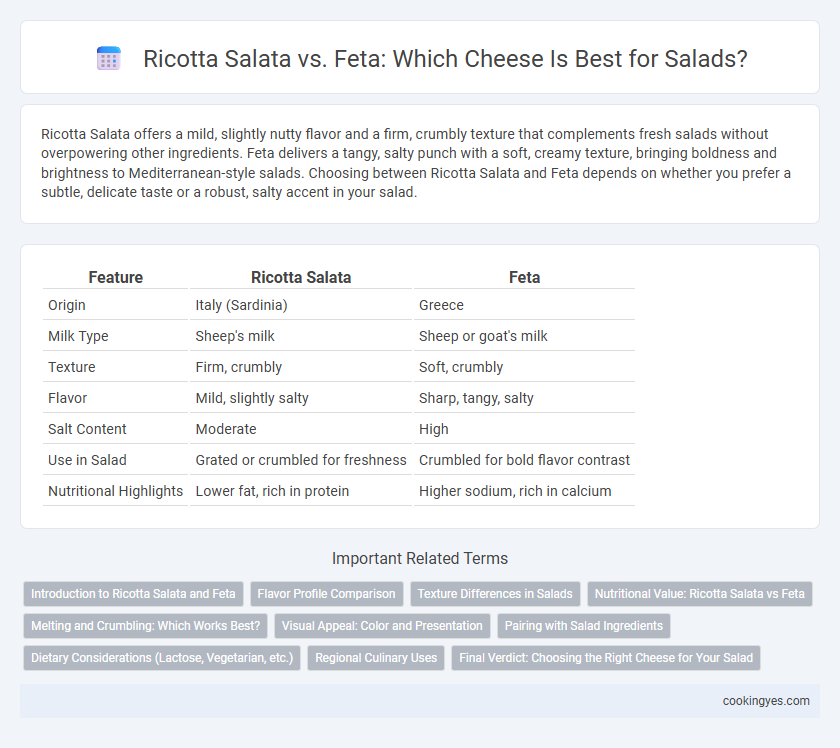Ricotta Salata offers a mild, slightly nutty flavor and a firm, crumbly texture that complements fresh salads without overpowering other ingredients. Feta delivers a tangy, salty punch with a soft, creamy texture, bringing boldness and brightness to Mediterranean-style salads. Choosing between Ricotta Salata and Feta depends on whether you prefer a subtle, delicate taste or a robust, salty accent in your salad.
Table of Comparison
| Feature | Ricotta Salata | Feta |
|---|---|---|
| Origin | Italy (Sardinia) | Greece |
| Milk Type | Sheep's milk | Sheep or goat's milk |
| Texture | Firm, crumbly | Soft, crumbly |
| Flavor | Mild, slightly salty | Sharp, tangy, salty |
| Salt Content | Moderate | High |
| Use in Salad | Grated or crumbled for freshness | Crumbled for bold flavor contrast |
| Nutritional Highlights | Lower fat, rich in protein | Higher sodium, rich in calcium |
Introduction to Ricotta Salata and Feta
Ricotta Salata and Feta are popular cheeses used in salads, each bringing unique textures and flavors. Ricotta Salata is a firm, salty cheese made from sheep's milk, known for its crumbly texture and mild, nutty taste. Feta, traditionally crafted from sheep or goat's milk, offers a tangy, briny flavor with a crumbly yet creamy texture, commonly associated with Mediterranean cuisine.
Flavor Profile Comparison
Ricotta Salata offers a mild, slightly nutty flavor with a firm yet crumbly texture that enhances salads without overpowering other ingredients. Feta delivers a tangy, salty, and sharp taste with a creamy crumbly texture, contributing a distinct Mediterranean character to dishes. Choosing between Ricotta Salata and Feta depends on the desired flavor intensity and saltiness in the salad.
Texture Differences in Salads
Ricotta Salata offers a firm, crumbly texture that adds a mild, slightly nutty flavor and a delicate, creamy bite to salads. Feta provides a crumbly yet moist consistency with a tangy, salty taste that enhances the freshness of greens and vegetables. The denser Ricotta Salata holds its shape better in salads, while feta's softer texture blends seamlessly, creating contrasting mouthfeel and flavor profiles.
Nutritional Value: Ricotta Salata vs Feta
Ricotta Salata contains about 100 calories and 7 grams of protein per ounce, with a moderate amount of calcium and lower sodium content compared to feta. Feta cheese provides roughly 75 calories and 4 grams of protein per ounce, but it is higher in sodium, making it a saltier option for salads. Both cheeses offer beneficial minerals, but Ricotta Salata is often preferred for a lower-sodium, higher-protein salad topping.
Melting and Crumbling: Which Works Best?
Ricotta Salata offers a firmer texture that crumbles beautifully without melting, making it ideal for salads that require a distinct cheese presence without losing shape. Feta, known for its briny flavor, crumbles easily but tends to soften rather than keep a firm bite, adding a creamy contrast to leafy greens. Choosing between Ricotta Salata and Feta depends on whether you prefer a cheese that retains structure or one that blends smoothly into salad components.
Visual Appeal: Color and Presentation
Ricotta Salata offers a bright white color and a firm, crumbly texture that enhances salad presentation with a clean and elegant look. Feta's creamy white to slightly off-white hue and crumbly yet moist consistency add a rustic and tangy appeal, creating visual contrast with vibrant salad ingredients. Both cheeses provide distinct aesthetics, but Ricotta Salata tends to deliver a more polished and refined appearance in salad plating.
Pairing with Salad Ingredients
Ricotta Salata offers a mild, nutty flavor and firm texture that pairs well with arugula, roasted beets, and toasted walnuts, enhancing fresh and earthy salad profiles. Feta cheese delivers a tangy, salty taste and crumbly texture ideal for Greek salads featuring tomatoes, cucumbers, olives, and red onions, adding a Mediterranean zest. Selecting Ricotta Salata or Feta depends on the desired flavor contrast and complement to the salad's ingredients, balancing creaminess with acidity or saltiness.
Dietary Considerations (Lactose, Vegetarian, etc.)
Ricotta Salata is a pressed, salted cheese made from sheep's milk whey, lower in fat and lactose compared to many cheeses, making it suitable for some lactose-sensitive individuals. Feta traditionally contains sheep or goat milk and is usually vegetarian-friendly but often unpasteurized, which can be a concern for certain diets; its higher sodium content may also impact heart-healthy choices. Both cheeses offer unique textures and flavors while accommodating different dietary needs such as reduced lactose tolerance or vegetarian preferences.
Regional Culinary Uses
Ricotta Salata, a pressed and salted version of ricotta cheese from Sicily, is favored in Mediterranean salads for its firm texture and mild, nutty flavor that complements fresh vegetables and herbs. Feta, originating from Greece, is a brined cheese known for its tangy, salty taste and crumbly texture, making it a staple in Greek and Middle Eastern salads like Greek salad and fattoush. Both cheeses enhance salads differently, with Ricotta Salata adding a subtle richness and feta providing a distinctively sharp and salty profile characteristic of Balkan and Eastern Mediterranean cuisines.
Final Verdict: Choosing the Right Cheese for Your Salad
Ricotta Salata offers a mild, creamy texture that enhances salads with a subtle, slightly salty flavor, perfect for balancing fresh greens without overpowering other ingredients. Feta provides a tangy, briny taste and crumbly texture that adds bold flavor and a Mediterranean flair, ideal for robust salads with cucumbers, olives, and tomatoes. Selecting between Ricotta Salata and Feta depends on the desired flavor intensity and texture, with Ricotta Salata suited for softer, nuanced profiles and Feta preferred for sharp, pronounced seasoning.
Ricotta Salata vs Feta for salad Infographic

 cookingyes.com
cookingyes.com